The ancient, original Halloween is darker than the US version
Skeletal hands crawl from letterboxes. Gravestones erupt from neat gardens. The country is covered in cobwebs. This is how Ireland does Samhain, the Celtic festival that marks the shift into the deep, northern winter.
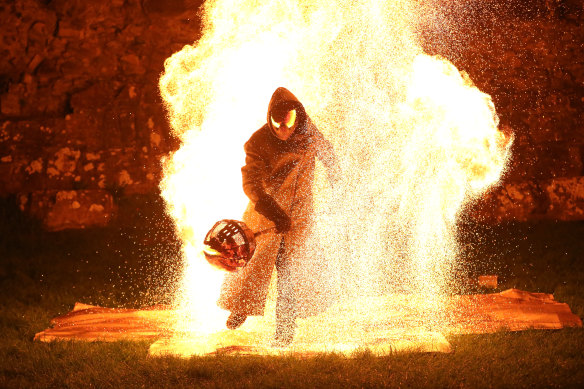
Dark rituals: the hooded-man emerges from the flames at Puca.
The ancestor of Halloween, Samhain has an otherworldly darkness far richer than the jump-scares of its corny, candy-flavoured cousin across the Atlantic. In its original incarnation, instead of New World pumpkins, turnips were carved into ghastly faces to ward off evil spirits. And the spirits aren’t chainsaw massacrists, but family who have passed into the next realm.
Just 45 minutes from Dublin, I’ve journeyed to Samhain’s heartland, the ancient castle town of Trim, in County Meath. Here, 5000-year-old passage tombs wend beneath green, grassy mounds at Bru na Boinne. The Book of Kells was written nearby and the landscape is dominated by the Hill of Tara – the political capital of ancient Ireland and the coronation site of the High Kings – and Tlachtga, or the Hill of Ward, the hearth of Samhain.
The stone walls of Trim’s 12th-century, Anglo-Norman castle are bathed in firelight as a drummer beats a blood-rousing tattoo, and a hooded man emerges from towering flames, heralded by a quartet of leather-clad, fire-spinning women.
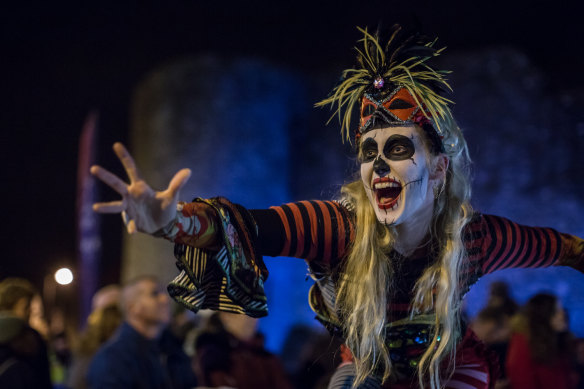
Halloween has nothing on Ireland’s Puca Festival.
This is the opening night of Puca, a modern Irish fire festival based on Samhain. It is named for the puca, a changeling spirit that roams between the worlds on such nights, when the veil between our world and the next falls away. Tonight, I am a torchbearer, a bringer of light in the dark night.
Carrying a raised lantern, I am walking in the Arrival of the Spirits parade through Trim. Around me, the steampunk parade rolls, marches and dances to the trill of fiddles, as if the fiddlers were being tortured by a dark overlord. Fast yet mournful, it is a macabre snippet of a dark dream, and the players marching alongside me include a fear dearg, a Red Man – a gruesome prankster of Celtic legend, who shuffles along with a sack over his head, dark eyeholes in a crumpled face. A mechanical horse skeleton ridden by the phantom queen, The Morrigan, rears behind me, while Horned Ones in the crowd hold masked, well-rugged children, eyes bright for a handful of thrown sweets.
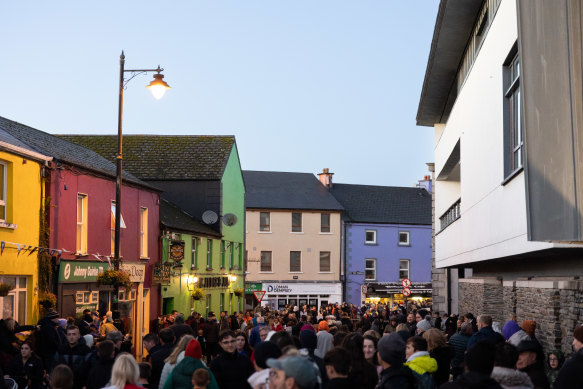
Puca festival-goers gather in Samhain’s heartland, the ancient castle town of Trim.
On the sidelines, a handful of protesters rail against what they see as a revival of paganism and dabbling in the occult.
Mischief and devilry abound, enticing us to play… but play carefully lest your fingers are burnt, or your soul deceived, warns ghost chronicler and guide Cynthia Simonet.
“The ancient Celts believed there were two parts of the year – the light and the dark – Samhain represents the dark part of the year,” says Cynthia. “And when the earth goes dark, the god of the underworld is no longer controlled by the sun, so he’s free to walk the earth, and with him are other spirits.”
Beware, she warns. We are all cloaked in disguise, but do you know who you’re really talking to on this night of dark revelry? As we tramp through Trim’s sinking graveyard, I shiver, and not just for the soft rain stealing down my sleeves, my neck and my shoes.
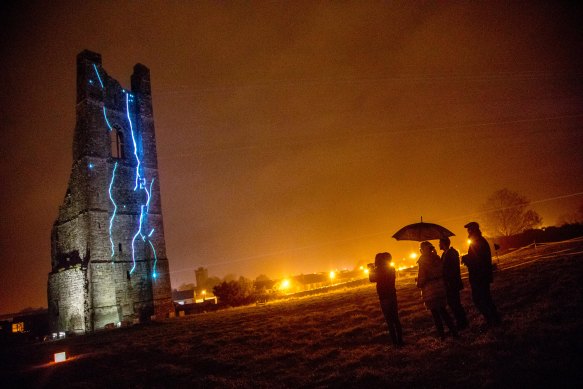
An ancient Trim castle lights up for festival-goers.Credit: Allen Kiely
“On All Souls Day, we pray for the souls of our dead and we pray that they’re at peace,” adds Cynthia. “But on Samhain, they walk amongst us.”
The next morning, on the eve of Samhain, a witch, complete with pointy hat and black robes, pours my morning tea with a ghastly, black-lipped smile, (plastic) spiders skitter from beneath the scrambled egg station at the Knightsbrook Hotel.
Like every hotel worth its salt, there’s a grand piano in the foyer, though the Knightsbrook’s is garnished with cobwebs and a full-sized skeleton playing such unholy hits as The Season of the Witch, Superstition and, of course, Ghostbusters.
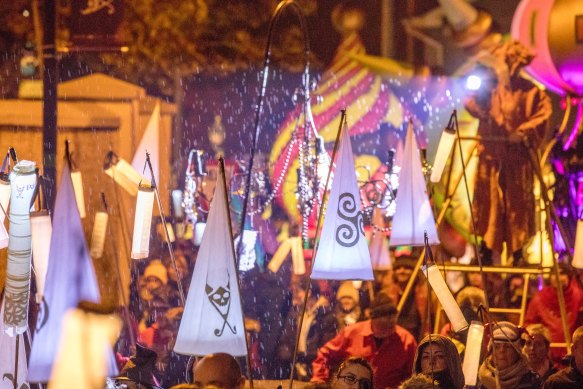
The town comes alive after dark.
At the Trim Tourist office, I duck to avoid being hit by a severed foot hanging from a chain and cruise the sideshows of the festival in the tents. The bars pulse with revelry, song and sword-wielding storytelling, the festival’s Big Top tents ring with the quips of Irish comedians and headlining musicians.
But it is quiet on Tlachtga. Legend goes that, from the late Bronze Age, all fires in Ireland were to be extinguished before Samhain. Then druids would light the first fire on this ceremonial site, to be sent out to the five ancient provinces of Ireland, to rekindle all hearths across the land.
As the rain persists, the new fire is sparked as a girl in naught but a white robe calls out greetings and the names of those who have died in the past year – as was the druidic tradition. We follow her, clutching small, flickering candles, down the ancient path of Tlachtga, then along muddy, hedge-lined lanes to the township of Athboy below, first settled as a druidic village at the foot of the sacred hill.
In welcoming Fagans’ pub, a fire and shots of heart-warming whiskey ensure we steam ourselves dry, and I find myself victoriously clutching a turnip - my prize won in a round of “banshee bingo”.
Finally, the pubs close and the bands finish. The circus tents are quiet and Trim Castle is enveloped into the darkness of the winter’s night. But the rekindled fires have claimed the victory for light, and we are safe again…for another year.
THE DETAILS
Tour
The Puca festival, centred around Trim, County Meath, runs from October 28 to 31 in 2023. See pucafestival.com.
Cynthia Simonet’s walking tours cost from $5 a person. See discoverboynevalley.ie.
Stay
The four-star Knightsbrook Hotel, Trim, costs from €118 ($196) a night, knightsbrook.com
The writer travelled as a guest of Tourism Ireland, see ireland.com.
Sign up for the Traveller Deals newsletter
Get exclusive travel deals delivered straight to your inbox. Sign up now.